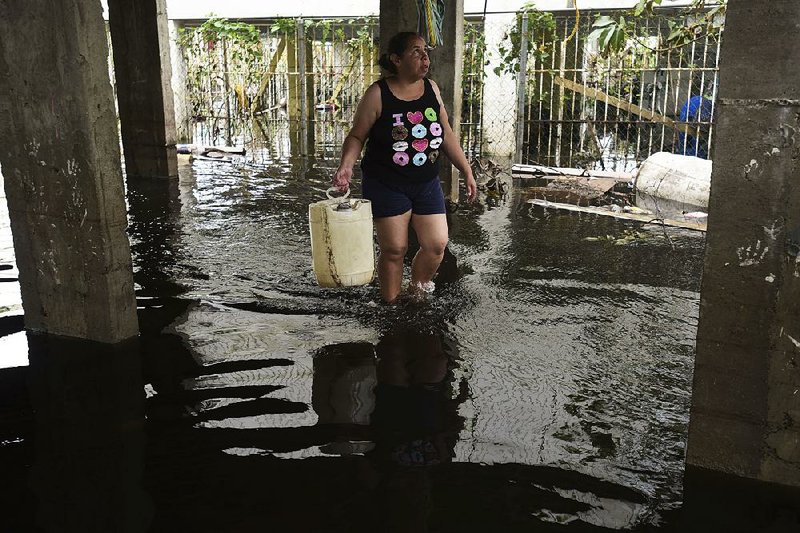The Pentagon will expand its response to the devastation in Puerto Rico left by Hurricane Maria, deploying a one-star Army general along with more aircraft, a hospital ship and a variety of specialized units all focused on relief efforts.
The moves followed a visit by Federal Emergency Management Agency Director Brock Long and the U.S. military's reopening of two major airfields capable of handling the Pentagon's cargo jets. Army Brig. Gen. Richard Kim, the deputy commanding general of U.S. Army North, will coordinate operations and make sense of what more is needed, defense officials said.
People in Puerto Rico have been desperate for more help, and many have criticized the federal government's decision-making. Pentagon officials have defended the military's response, however, saying it has supplied everything FEMA has requested while preparing for a long-term recovery effort.
Combined, there are about 5,000 active-duty U.S. service members and National Guardsmen on duty assisting Puerto Rico, including more than 1,000 who work from the USS Kearsarge and USS Oak Hill, ships deployed off the coast of Puerto Rico, said Army Lt. Col. Jamie Davis, a Pentagon spokesman. Far more were involved in the recent responses to Hurricane Irma and Hurricane Harvey.
Click here for larger versions
Photos by The Associated Press
Photos by The Associated Press
Elaine Duke, the acting secretary of homeland security, called the deployment of Kim a "big step forward," telling Senate lawmakers Wednesday that his presence will help accelerate decision-making on the ground.
The U.S. military also has opened a former base, Naval Station Roosevelt Roads. The flight line there can accommodate military jets, freeing the Luis Munoz Marin Airport near San Juan to accept commercial flights to and from the U.S. mainland. That airport was opened Friday by the U.S. Army Corps of Engineers and since then has seen a fleet of incoming military jets carrying supplies.
"What [the Defense Department] is doing is helping us get the supplies there, but also helping us open the access roads," Duke said. "They also are leading the debris removal, which is huge."
Maribel Valentin Espino and her husband of Montebello said they have not seen anyone from the Puerto Rican government, much less FEMA, since the storm tore up the island Sept. 20, killing at least 16 people and leaving nearly all 3.4 million people in Puerto Rico without power and most without water.
"People say FEMA is going to help us," Valentin said Tuesday as she showed journalists around the wreckage of her home. "We're waiting."
Air Force Gen. Lori Robinson, who oversees the military response as chief of U.S. Northern Command, said at an event in Washington that more units and equipment will arrive in the next day or two.
"You have to understand what is happening on the ground so you don't add to the burden, but to make sure you put the right capability and capacity," she said. "So, whether it's power generators or whether it's water and food, those are things that we already have been shipping in."
The Pentagon effort remains smaller than relief operations marshaled after other major natural disasters, including Hurricane Katrina in 2005 and a 2013 typhoon that devastated the Philippines. In those cases, the military established a joint task force led by a three-star general. Critics of the response to Maria, including Rep. Adam Smith, D-Wash., the ranking member of the House Armed Services Committee, has called for the Pentagon to do so in Puerto Rico, too.
Asked what additional needs there might be, Robinson said, "We haven't caught our breath yet." She added that the military intends to determine what lessons should be learned from Hurricane Maria.
Meanwhile, Maria regained strength and became a hurricane again, pushing water over both sides of North Carolina's Outer Banks and taking its time to slowly turn away from the U.S. Atlantic coast.
No injuries have been reported, but the surge of ocean water washed over eroded beaches, flooding properties and state North Carolina 12, the only road through the narrow barrier islands of Hatteras and Ocracoke.
No ferries were moving, cutting off access to Ocracoke, and with parts of the highway flooded even at low tide, any travel on Hatteras remains hazardous, Dare County Emergency Management Director Drew Pearson said in an email. He said the worst problems were on Hatteras Island, where more than 10,000 visitors left under an evacuation order, but hundreds of residents were allowed to stay.
The National Hurricane Center said an Air Force Reserve reconnaissance aircraft measured Maria's top sustained winds at near 75 mph, with higher gusts. Its center was about 180 miles off Cape Hatteras at 2 p.m. Wednesday.
While Maria's most punishing hurricane-force winds remained offshore, tropical storm-force winds extended for as much as 230 miles from the center, churning up the surf on both sides of the islands. The hurricane's forward speed is 6 mph, causing it to linger before swinging out to sea.
"Mother Nature keeps chopping at it," said Tony Meekins, 55, a lifelong resident of Avon who works as an engineer on the temporarily halted Hatteras-Ocracoke ferry. "We see storm after storm."
Information for this article was contributed by Dan Lamothe of The Washington Post and by Ben Finley, Danica Coto and Jack Jones of The Associated Press.
A Section on 09/28/2017
